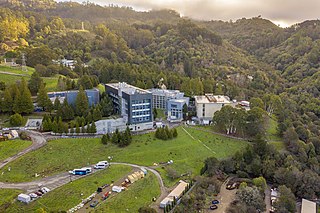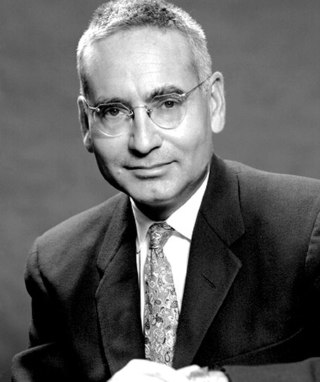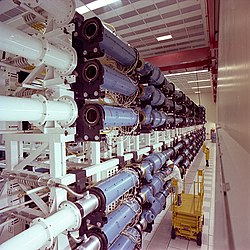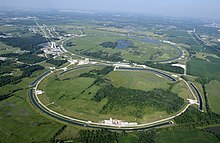
Heike Kamerlingh Onnes was a Dutch physicist and Nobel laureate. He exploited the Hampson–Linde cycle to investigate how materials behave when cooled to nearly absolute zero and later to liquefy helium for the first time, in 1908. He also discovered superconductivity in 1911.

Lawrence Berkeley National Laboratory (LBNL) is a federally funded research and development center in the hills of Berkeley, California, United States. Established in 1931 by the University of California (UC), the laboratory is sponsored by the United States Department of Energy and administered by the UC system. Ernest Lawrence, who won the Nobel prize for inventing the cyclotron, founded the Lab and served as its Director until his death in 1958. Located in the Berkeley Hills, the lab overlooks the campus of the University of California, Berkeley.

Science policy is concerned with the allocation of resources for the conduct of science towards the goal of best serving the public interest. Topics include the funding of science, the careers of scientists, and the translation of scientific discoveries into technological innovation to promote commercial product development, competitiveness, economic growth and economic development. Science policy focuses on knowledge production and role of knowledge networks, collaborations, and the complex distributions of expertise, equipment, and know-how. Understanding the processes and organizational context of generating novel and innovative science and engineering ideas is a core concern of science policy. Science policy topics include weapons development, health care and environmental monitoring.

The Atomic Energy Research Establishment (AERE) was the main centre for atomic energy research and development in the United Kingdom from 1946 to the 1990s. It was created, owned and funded by the British Government.

The Santa Fe Institute (SFI) is an independent, nonprofit theoretical research institute located in Santa Fe, New Mexico, United States and dedicated to the multidisciplinary study of the fundamental principles of complex adaptive systems, including physical, computational, biological, and social systems. The institute is ranked 24th among the world's "Top Science and Technology Think Tanks" and 24th among the world's "Best Transdisciplinary Research Think Tanks" according to the 2020 edition of the Global Go To Think Tank Index Reports, published annually by the University of Pennsylvania.

The Superconducting Super Collider (SSC) was a particle accelerator complex under construction in the vicinity of Waxahachie, Texas, United States.

The United States Department of Energy National Laboratories and Technology Centers is a system of laboratories overseen by the United States Department of Energy (DOE) for scientific and technological research. The primary mission of the DOE national laboratories is to conduct research and development (R&D) addressing national priorities: energy and climate, the environment, national security, and health. Sixteen of the seventeen DOE national laboratories are federally funded research and development centers administered, managed, operated and staffed by private-sector organizations under management and operating (M&O) contracts with the DOE. The National Laboratory system was established in the wake of World War II, during which the United States had quickly set-up and pursued advanced scientific research in the sprawling Manhattan Project.

Wander Johannes de Haas was a Dutch physicist and mathematician. He is best known for the Shubnikov–de Haas effect, the De Haas–Van Alphen effect and the Einstein–de Haas effect.
A research institute, research centre, research center or research organization is an establishment founded for doing research. Research institutes may specialize in basic research or may be oriented to applied research. Although the term often implies natural science research, there are also many research institutes in the social science as well, especially for sociological and historical research purposes.
The military funding of science has had a powerful transformative effect on the practice and products of scientific research since the early 20th century. Particularly since World War I, advanced science-based technologies have been viewed as essential elements of a successful military.

Alvin Martin Weinberg was an American nuclear physicist who was the administrator of Oak Ridge National Laboratory (ORNL) during and after the Manhattan Project. He came to Oak Ridge, Tennessee, in 1945 and remained there until his death in 2006. He was the first to use the term "Faustian bargain" to describe nuclear energy.
Through history, the systems of economic support for scientists and their work have been important determinants of the character and pace of scientific research. The ancient foundations of the sciences were driven by practical and religious concerns and or the pursuit of philosophy more generally. From the Middle Ages until the Age of Enlightenment, scholars sought various forms of noble and religious patronage or funded their own work through medical practice. In the 18th and 19th centuries, many disciplines began to professionalize, and both government-sponsored "prizes" and the first research professorships at universities drove scientific investigation. In the 20th century, a variety of sources, including government organizations, military funding, patent profits, corporate sponsorship, and private philanthropies, have shaped scientific research.
The Science and Technology Facilities Council (STFC) is a United Kingdom government agency that carries out research in science and engineering, and funds UK research in areas including particle physics, nuclear physics, space science and astronomy.
The Office of Science is a component of the United States Department of Energy (DOE). The Office of Science is the lead federal agency supporting fundamental scientific research for energy and the Nation’s largest supporter of basic research in the physical sciences. The Office of Science portfolio has two principal thrusts: direct support of scientific research and direct support of the development, construction, and operation of unique, open-access scientific user facilities that are made available for use by external researchers.

Bruceton is an unincorporated suburb of Pittsburgh within Allegheny County, Pennsylvania, United States. It is part of the Greater Pittsburgh metropolitan region. Its western half is part of South Park Township and its eastern half is part of Jefferson Hills.

Maxwell’s thermodynamic surface is an 1874 sculpture made by Scottish physicist James Clerk Maxwell (1831–1879). This model provides a three-dimensional space of the various states of a fictitious substance with water-like properties. This plot has coordinates volume (x), entropy (y), and energy (z). It was based on the American scientist Josiah Willard Gibbs’ graphical thermodynamics papers of 1873. The model, in Maxwell's words, allowed "the principal features of known substances [to] be represented on a convenient scale."

Edward Creutz was an American physicist who worked on the Manhattan Project at the Metallurgical Laboratory and the Los Alamos Laboratory during World War II. After the war he became a professor of physics at the Carnegie Institute of Technology. He was Vice President of Research at General Atomics from 1955 to 1970. He published over 65 papers on botany, physics, mathematics, metallurgy and science policy, and held 18 patents relating to nuclear energy.
Tettje Clay-Jolles (1881–1972) was one of the first female Dutch physicists. She studied the variation of atmospheric radiation with geographic latitude.
The Princeton Three was a group of two physicists and a political economist working at the Princeton University during the Cold War Era. Of the three men Eugene Wigner and John Archibald Wheeler studied physics and Oskar Morgenstern studied political economy. Their main goal was to establish a national science laboratory in the United States of America that would help America catch the Soviet Union in the Intermediate range ballistic missile (IRBM) race, as well as push the United States ahead in the space race. The basic outline of this laboratory called for university scientists to have complete and open insight to the militaristic needs if the country in order to spend some two or three years working full-time, without the shackles of administrative bodies or security restrictions. They would use their specific field of study to improve the defense systems of the military and other important project deemed necessary.
Little Science, Big Science is a book of collected lectures given by Derek J. De Solla Price, first published in 1963. The book presents the 1962 Brookhaven National Laboratory Pegram Lectures, a series of lectures dedicated to discussing science and its place in society. Price's goal in the lectures is to outline what it may look like for science to be analysed scientifically, by applying methods of measuring, hypothesizing, and deriving to science itself. With this goal in mind, he sets out to define quasi-mathematically how the shape and size of science has shifted from "small science" to "big science" in a historical and sociological way. Price presents a quantification of science as a measurable entity via an analogy to thermodynamics, conceptualizing science like a gas with individual molecules possessing individual velocities and interactions, a total volume, and general properties or laws.













